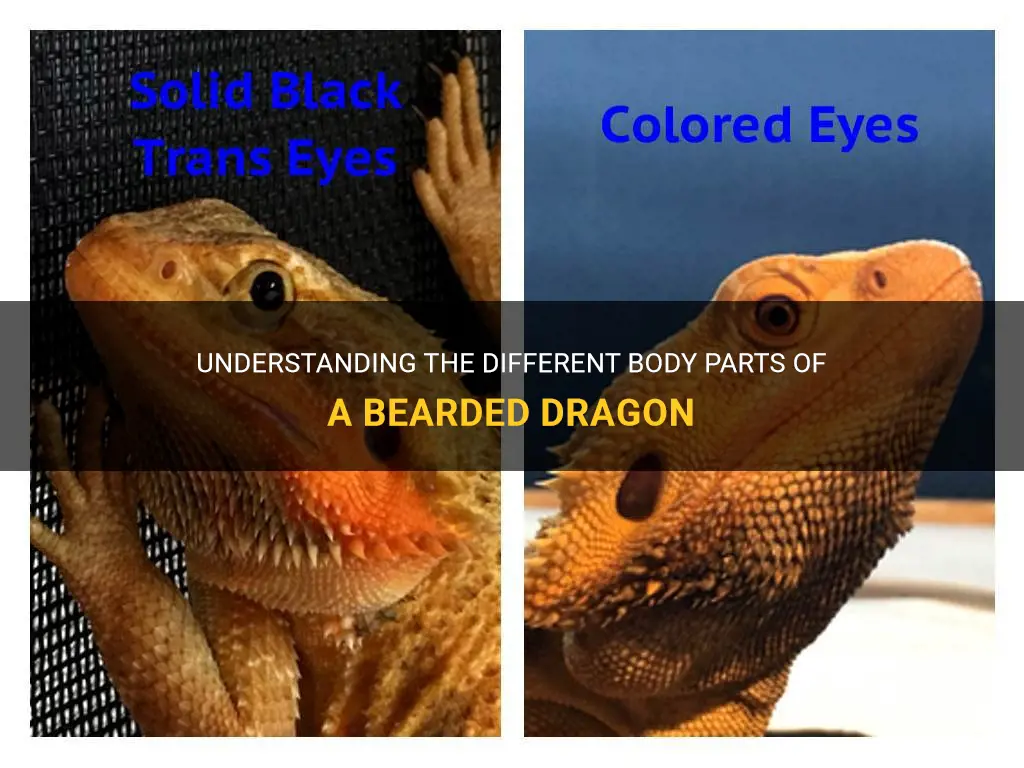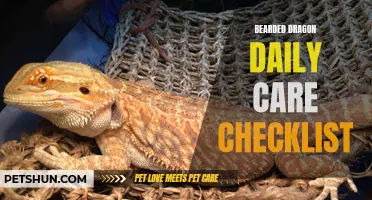
The bearded dragon, known for its majestic appearance and captivating personality, is a fascinating reptile with a multitude of intriguing body parts. From its unique, spiky beard to its powerful tail and formidable claws, each aspect of the bearded dragon's physique tells a fascinating story of adaptation and survival. In this article, we will delve into the world of bearded dragon body parts, exploring their function, significance, and how they contribute to these marvelous creatures' overall enchanting charm.
What You'll Learn

What are the main body parts of a bearded dragon?
Bearded dragons are fascinating reptiles that make popular pets due to their docile nature and unique appearance. To fully understand and care for these reptiles, it's important to know about their anatomy and the various body parts that make them who they are.
Here, we will discuss the main body parts of a bearded dragon and their functions:
- Head: The head of a bearded dragon is triangle-shaped and adorned with rows of scales that give them their distinctive beard. These scales can puff up and darken, especially in males, when they feel threatened or want to display dominance. The head also houses the reptile's eyes, nostrils, and mouth.
- Eyes: Bearded dragons have a pair of round, bulging eyes that offer excellent vision. They can scan the environment for potential threats or prey and help them navigate their surroundings. The eyes are also capable of limited color vision, enabling them to detect certain hues.
- Ears: Bearded dragons possess small ear openings, located just behind their eyes. These ear openings are equipped with a thin layer of skin that helps protect their sensitive ears from dust and debris. While bearded dragons primarily rely on their vision and other senses, they can detect low-frequency sounds.
- Mouth: The mouth of a bearded dragon is filled with sharp teeth, which they use to grasp and chew their food. These reptiles are omnivores and consume a wide variety of food, including insects, vegetables, and fruits. Bearded dragons don't possess lips like humans; instead, their mouths are lined with a series of small scales.
- Tongue: One of the most fascinating aspects of bearded dragon anatomy is their tongue. Their tongue is long and thin, covered in tiny taste buds that help them identify the taste and smell of their prey. They can flick their tongues in and out at high speeds to capture insects or detect the presence of potential mates.
- Body: Bearded dragons have a robust body covered in scales. These scales offer protection from predators and help retain moisture. The body is divided into distinct regions, including the neck, back, abdomen, and tail. The body is supported by strong limbs with sharp claws, which allow them to grip onto branches or climb surfaces.
- Beard: The signature feature of bearded dragons is their beard. This beard is composed of specialized scales called "scutes" that can be puffed up when the reptile feels threatened or wants to display dominance. The color of the beard can vary from pale yellow to deep black, depending on the individual bearded dragon and its mood.
- Tail: The tail of a bearded dragon is long and tapering. It serves multiple functions, including balance, communication, and fat storage. Bearded dragons store fat reserves in their tail, which they use during periods of food scarcity. In addition, they can also wave their tail as a form of communication, especially during courtship and territorial displays.
Understanding the anatomy of a bearded dragon is crucial for their proper care and well-being. By knowing their body parts and functions, you can better meet their needs and provide a suitable and enriching environment for them to thrive. Whether you are a bearded dragon owner or simply curious about these fascinating reptiles, this knowledge will deepen your appreciation for these incredible creatures.
Can Bearded Dragons Eat Potatoes?
You may want to see also

How does a bearded dragon use its tail?
Bearded dragons, also known as beardies, are fascinating reptiles that have become popular pets in recent years. One of the most distinctive features of these reptiles is their long, muscular tails. But how exactly do bearded dragons use their tails?
The tail of a bearded dragon serves several important purposes. Firstly, it acts as a counterbalance. When a bearded dragon is walking or climbing, its tail helps to stabilize its body and prevent it from tipping over. This is especially important when the lizard is climbing trees or rocks, as without a well-balanced tail, it would be much more difficult for it to maintain its footing.
In addition to serving as a counterbalance, the tail of a bearded dragon also plays a role in communication. When a bearded dragon is feeling threatened or defensive, it can puff up its tail, making it appear larger and more intimidating to potential predators. This behavior is known as "tail puffing" and is a warning sign to other animals that the bearded dragon is prepared to defend itself if necessary.
Furthermore, the tail of a bearded dragon stores fat reserves that the lizard can use as a source of energy when food is scarce. Bearded dragons are able to store significant amounts of fat in their tails, which allows them to survive for extended periods of time without eating. This adaptation is particularly useful in their natural habitats where food may be scarce during certain seasons.
Another interesting use of the tail is in reproduction. Male bearded dragons have hemipenal bulges at the base of their tails, which are used during mating. These bulges become more pronounced during the breeding season and help the male to grip the female's body during copulation.
It is also worth noting that the tail of a bearded dragon can break off if it is grabbed or caught in something. This behavior, known as "tail autotomy", is a defense mechanism that allows the lizard to escape from predators. The detached tail will continue to wriggle, distracting the predator while the bearded dragon makes its escape. The tail will eventually regenerate, although the new tail will not be as long or as well-developed as the original.
In conclusion, the tail of a bearded dragon serves multiple important functions. It acts as a counterbalance, aids in communication, stores fat reserves, facilitates reproduction, and can be sacrificed as a means of escape. The tail is a fascinating and versatile appendage that plays a crucial role in the life of a bearded dragon.
Boosting Bearded Dragon's Appetite: Effective Stimulants and Techniques
You may want to see also

What are the different types of scales on a bearded dragon's body?
When it comes to the body of a bearded dragon, there are several different types of scales that can be found. These scales serve several important functions for the bearded dragon, including protection, thermoregulation, and communication. In this article, we will explore the different types of scales found on a bearded dragon's body and how they contribute to its overall health and well-being.
The first type of scales that can be found on a bearded dragon are the dorsal scales. These are the large scales that run along the back of the bearded dragon, from the neck to the tail. These scales provide protection for the bearded dragon's spine and internal organs, helping to prevent injury from falls or other physical trauma. Additionally, the dorsal scales can also change color, serving as a form of communication. For example, when a bearded dragon is feeling threatened or aggressive, the dorsal scales may darken or become more pronounced, signaling to other animals that it is not to be messed with.
Another type of scales on a bearded dragon are the ventral scales. These are the scales that cover the belly of the bearded dragon, offering protection to its delicate underbelly. The ventral scales also play a role in thermoregulation, as they can help to absorb and distribute heat from the environment. This is important for the bearded dragon's overall health, as it relies on external heat sources to maintain its body temperature.
On the bearded dragon's head, there are unique scales known as the rostral and nasal scales. These scales cover the bearded dragon's snout and are responsible for protecting its sensitive nasal passages and sense organs. The rostral and nasal scales are often more pronounced in male bearded dragons, as they are used in combat during mating season.
In addition to these larger scales, there are also smaller scales that can be found all over a bearded dragon's body. These scales are responsible for providing the bearded dragon with a layer of protection against pathogens and environmental stressors. They also help to regulate moisture levels, as they can absorb and release water as needed. These small scales may also contribute to the bearded dragon's overall appearance, as they can have unique colors and patterns.
It is important to note that the condition of a bearded dragon's scales can be indicative of its overall health. If a bearded dragon's scales appear dull, discolored, or are falling off, it could be a sign of an underlying health issue such as dehydration or a skin infection. Regularly inspecting a bearded dragon's scales and providing proper care, such as regular bathing and maintaining optimal humidity levels in its enclosure, can help ensure that its scales remain healthy and intact.
In conclusion, the scales on a bearded dragon's body play a crucial role in its overall health and well-being. From providing protection to aiding in thermoregulation and communication, these scales are essential for the bearded dragon's survival. By understanding the different types of scales on a bearded dragon's body and taking proper care of them, reptile owners can help ensure that their pets remain happy and healthy for years to come.
The Snow Bearded Dragon: A Rare and Unique Species
You may want to see also

How do bearded dragons use their mouths and teeth?
Bearded dragons are fascinating reptiles known for their unique appearance and quirky behaviors. One aspect of their biology that is often overlooked is their use of their mouths and teeth. Understanding how bearded dragons utilize their mouth and teeth can provide valuable insight into their natural behavior and overall health.
Bearded dragons, like most reptiles, have specialized teeth that are adapted to their specific diet. Their teeth are sharp and pointed, which allows them to easily capture and consume their prey. Bearded dragons are omnivores, meaning they eat both plant material and small insects. Their teeth are well-suited for tearing apart the tough exoskeletons of insects and crushing plant matter.
When it comes to hunting and feeding, bearded dragons use their mouths in a strategic and efficient manner. They have a strong bite force and can easily overpower their prey. Once they have captured their food, they use their teeth to masticate and break it down into small, manageable pieces. This allows for easier digestion and absorption of nutrients.
In addition to their role in feeding, bearded dragons also use their mouths for social interactions and defense. Like many reptiles, bearded dragons engage in "mouth gaping," where they open their mouths wide to display their teeth and intimidate potential threats. This behavior is often accompanied by head bobbing and arm waving, which further emphasize their dominance.
Bearded dragons may also use their mouths to defend themselves when feeling threatened. If they are handled improperly or feel cornered, they may resort to biting as a form of defense. While their teeth are not venomous, their bite can still cause injury and should be avoided.
Maintaining proper oral hygiene is crucial for the overall health of a bearded dragon. Regular brushing of their teeth with a soft-bristled toothbrush can help remove food particles and prevent the buildup of plaque and tartar. It is also important to provide them with a varied and balanced diet that promotes good dental health.
In conclusion, bearded dragons utilize their mouths and teeth for a variety of purposes, including hunting, feeding, social interactions, and defense. Their sharp and pointed teeth are specialized for tearing apart their prey and processing plant material. Understanding these unique characteristics can help us better appreciate the incredible adaptations of these fascinating reptiles. By promoting proper oral hygiene and providing a nutritious diet, we can ensure the health and well-being of these beloved pets.
Bearded Dragon Enjoying a Refreshing Watermelon Snack
You may want to see also

What role do a bearded dragon's eyes play in its survival and behavior?
Bearded dragons, scientifically known as Pogona, are fascinating reptiles with unique characteristics. One of the most striking features of these creatures is their eyes. Bearded dragons have large, round eyes located on either side of their head. These eyes play a crucial role in both their survival and behavior.
First and foremost, a bearded dragon's eyes are essential for its survival. As diurnal animals, bearded dragons are active during the day and rely heavily on their vision to navigate their surroundings and find food. Their eyes are adapted for excellent depth perception and color vision, allowing them to accurately judge distances and locate prey.
In addition to their vision, bearded dragons also possess a special eye structure known as a parietal or third eye. This unique eye is located on the top of their head and is used primarily for detecting predators from above. This third eye is sensitive to changes in light intensity and movement, providing an early warning system for potential threats.
Apart from their role in survival, a bearded dragon's eyes also play a significant role in their social behavior. These reptiles have unique eye behaviors that are used for various communication purposes. For example, during courtship displays, male bearded dragons can exhibit "eye bulging" behavior. This involves inflating their throat and puffing out their eyelids, creating a display of dominance and attractiveness to potential mates.
Another important aspect of social behavior in bearded dragons is their ability to recognize familiar individuals. Research has shown that these reptiles can distinguish between familiar and unfamiliar individuals based on visual cues, including eye color and shape. This recognition plays a crucial role in their social interactions, hierarchy establishment, and territorial defense.
Furthermore, a bearded dragon's eyes can reveal its emotional state. Similar to humans, these reptiles can display certain eye expressions depending on their mood. For instance, if a bearded dragon is feeling threatened or stressed, it may exhibit a wide-eyed stare, indicating fear or aggression. On the other hand, if the reptile is content and relaxed, its eyes may appear half-closed or squinted.
In conclusion, a bearded dragon's eyes are not only essential for its survival but also play a vital role in its behavior and social interactions. These reptiles rely on their excellent vision, including their third eye, to navigate their surroundings, detect predators, and find food. Additionally, their eyes are used for various communication purposes, including courtship displays and recognizing familiar individuals. Understanding the importance of a bearded dragon's eyes can further enhance our understanding and appreciation of these fascinating creatures.
Do Bearded Dragons Have Night Vision: Unveiling Their Surprising Adaptations
You may want to see also
Frequently asked questions
The tail of a bearded dragon serves multiple purposes. It is primarily used for balance and stability while climbing and moving around. The tail also acts as a storage reserve for fat, which can be used as an energy source during periods of low food availability.
The length of a bearded dragon's tail can vary depending on its age and overall health. On average, an adult bearded dragon's tail can measure between 6 to 12 inches in length. However, some individuals may have tails that exceed 12 inches.
Yes, bearded dragons do have teeth. However, their teeth are not designed for chewing or tearing food like mammals' teeth. Bearded dragons have small, sharp teeth that are used for gripping and holding their prey. They will typically swallow their food whole rather than chewing it.
The spikes, or scales, on a bearded dragon's body serve as a form of protection. When threatened or during territorial displays, they will puff out their throat and flatten their body, making their spikes stand up. This makes them appear larger and more intimidating to potential predators or rivals.
The "beard" of a bearded dragon is a loose, stretchy flap of skin located under its lower jaw. It can expand and darken in color, giving the appearance of a beard. This behavior is commonly associated with stress or aggression. It serves as a warning sign to potential threats, allowing the bearded dragon to appear more intimidating.







